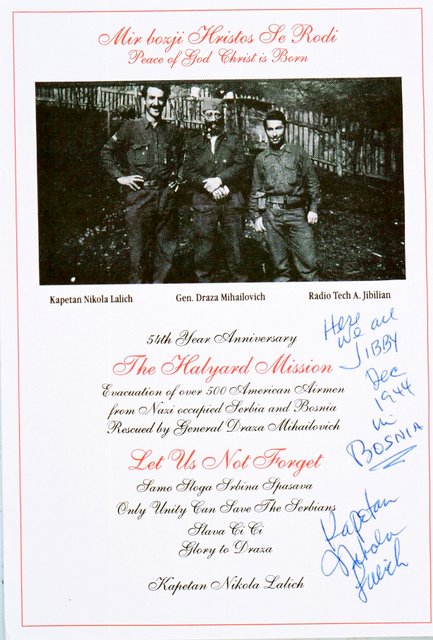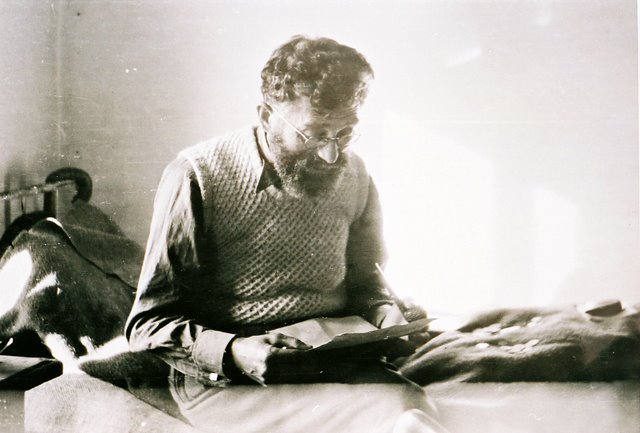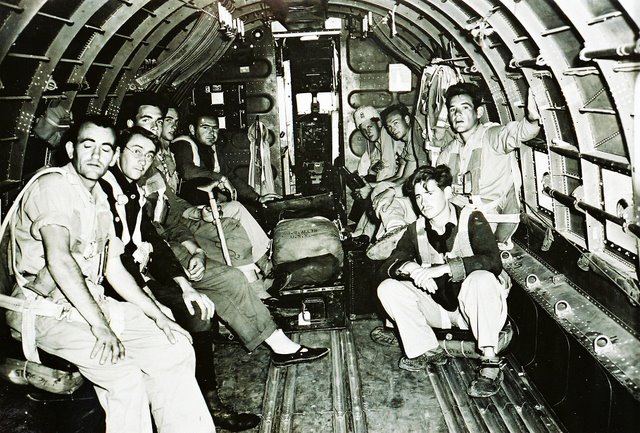
Above: American airmen together with Serbs, last day in Yugoslavia before departing to Bari, Italy. Jibilian is the second from the left standing. Captain Lalich is located in the middle of the first row (behind the machine gun). OSS agent Nick Lalich (center) with some of the last fliers to be taken out in Operation Halyard, on December 27, 1944.

Above: Americans with a nurse changing locations to hide from Germans. On the far right is a American with binoculars looking for enemy troops.

Above: Commander Musilin is located third from the left standing. Captain Lalich is standing on the far right of this photo. Jibilian is located in the middle of the first row.

Above: Serbs and American airmen together. Draza Mihailovic, Commander of the Royal Yugoslav Army, is standing in the middle of the back row (wearing a hat and beard). Jibilian is located in the first row, third from the left (light jacket). December, 1944.

Above: Americans loading into an airplane, December 1944.
.jpg)
Above: Draza Mihailovic, Commander of the Royal Yugoslav Army, gave a photo of himself to Jibby Jibilian. On the back side of the photo, General Mihailovic wrote:
“To Mr. Jibby Jibilian, Co-fighter and friend in those difficult days during the fight for Liberty
– General Draza Mihailovic (October 5, 1944)”.

Above: George Vujnovich (standing, right) greets Nick Lalich (standing, center, with mustache) and the last group of downed airmen returning from Pranjane, Yugoslavia, on December 28, 1944.

Above: Doctor Mitrani and his assistant checking medical supplies. Because medical supplies were in short supply, many operations done by Doctor Mitrani at that time were performed without anesthesia.

Above: Captain Lalich and Jibilian are composing a message to send over radio to Bari, Italy.

Above: Jibby Jibilian (January, 1945) in Bari, Italy.

Above: American pilot of a C-47 plane in Pranjane, waiting to transport airmen to Bari, Italy.

Above: American planes waiting for American airmen to transport to Italy in Kochevo, Serbia. Two of this airplanes are damaged during landing because of a short landing stripe.

Above: Draza Mihailovic, Commander of the Royal Yugoslav Army, with Serbian priests during a religious ceremony, in Pranjane, August 1944.

Above: Serbian village. Draza Mihailovic, Commander of the Royal Yugoslav Army is located in the center of this photo.

Above:A typical Serbian village in the mountains of central Yugoslavia, with ox carts being readied for helping wounded American airmen travel to Pranjane.

Above: Doctor Mitrani treating a wounded American airman in Pranjane, 1944.

Above: Americans fliers on a C-47, on the way from Pranjane, Yugoslavia, to Bari, Italy.

Above: American airmen land in Bari, Italy, 1944.

Above: Allied airmen sleeping in Serbian homes, hiding from German patrols while awaiting rescue.

Above: Serbian field with enemy airplane in the background. Jibby Jibilian, radio operator, transmitted messages to Bari, Italy. German radio operators located Jibilian’s coordinates and sent German planes to bombard him. Jibilian bearly escaped alive.

Above: George Kraigher (left) and George Vujnovich (right) celebrate with the Operation Halyard team returning on its final flight from Yugoslavia on December 28, 1944. Nick Lalich is standing in the center with mustache, and Arthur Jibilian is to the right of him.

Above: Photo of Nick Lalich, Draza Mihailovic (Commander of the Royal Yugoslav Army) and Radio Tech A. Jibilian in Bosnia, 1944 hiding from Germans. This is a postcard sent from Captain Lalich to Jibilian.

Above: OSS agent Nick Lalich (standing, center), with OSS radio operator Arthur Jibilian (kneeling, left) and others in Pranjane, Yugoslavia, December 1944.

Above: American airmen on a rescue plane back to Italy, some warming their feet in canvas bags because they gave their shoes to local villagers before leaving Pranjane, Yugoslavia.

Above: American airmen loading onto an airplane, leaving for Italy.

Above:A typical Serbian village in the mountains of central Yugoslavia.

Above: Arthur “Jibby” Jibilian kneeling and holding a signaling devise (at night) to signal US airplanes to safely land on Pranjane Airfield to rescue downed American airmen. These airplanes, after landing, took the American airmen from Pranjane to Bari, Italy.

Above (from left to right): Captain Nick Lalich, Mike Rajacich and Muselin.

Above: Band of American soldiers and Serbs moving to various locations to avoid German paroles. Commander MacDowell of the US Ranger Mission is on the left riding a horse.

Above: American airmen on a C-47 on the way from Pranjane, Yugoslavia, to Bari.

Above: Koceljevo Airfield was used as a substitute airfield to rescue American airmen when Pranjane airfield was occupied, at the time, by Germans.

Above:A typical Serbian village in the mountains of central Yugoslavia, with ox carts being readied for helping wounded American airmen travel to Pranjane.

Above: General Draza Mihailovic with McDowell, Commander of the Ranger Mission and another officer. Draza points to German locations on a map.

Above: American airmen in Pranjane, Serbia. From left to right: Mike Rajacic, Commander McDowell of the US Ranger Mission, Captain Milo Dragovic and radio operator for the Ranger Mission Mike Devijac.

Above: Draza Mihailovic, Commander of the Royal Yugoslav Army and American Commander MacDowell of the US Ranger Mission behind him inspecting the troops.

Above: Arthur “Jibby” Jibilian kneeling and holding a signaling devise (at night) to signal US airplanes to safely land on Pranjane Airfield to rescue downed American airmen. These airplanes, after landing, took the American airmen from Pranjane to Bari, Italy.
Above: American airplane damaged by landing. These damaged airplanes were still used for flying to Bari, Italy. In order to reduce weight, pilots empty the gas tanks to the minimum amount needed to get to Bari, Italy.

Above: A hospital in Bari, Italy with Jibby Jibilian(far left) and Captain Lalich(far right) visting wounded American airmen.

Above: An injured American airman leans on a cane while waiting to board a rescue plane in Pranjane, Yugoslavia. He and the other airmen are using pieces of parachute sik as scarves.

Above: Rescued American airmen arriving in Bari, Italy from Pranjane, Serbia.

Above: Draza Mihailovic, Commander of the Royal Yugoslav Army, in his homeland of Serbia reading correspondences (October, 1944).

Above: Panorama view of a Serbian village.

Above: American airmen on a C-47 on the way from Pranjane, Yugoslavia, to Bari.









.jpg)





































Great article and photos.
An incredible, true story of courage, grit, and determination. The Serbs are to be praised for their many sacrifices for our U.S. airmen. God bless them all. We made a grave error in supporting Tito.
Unfortunately, the book ”Forgotten 500” failed to tell the truth.
The Tito’s Partisans rescued more than 2300 Allied airmen and that fact was never mentioned in the book. Most of those were rescued by Croat Partisans, since the majority of U.S. planes went down over Croatia. Also a great number of RAF personnel was rescued too.
The Chetniks collaborated with Germans throughout the war and that’s the fact. Calling them Antifascists is just disgracefully!
..Even if your statement were true- the fact remains that 80% of “Croatian Partisans” actually were Serbs (from what we call today “Croatia”), while the best majority of Croats in WWII were either fascists or “the active fascist”s supporters”.
So, on the either side of “this equation”, the Allied pilot’s saviors in fact were Serbs.
Another false statement on your part- The so called “Chetniks” who rescued hundreds of Allied pilots were the members of the Yugoslavian Homeland Royal Army (who were never officially referred as “Chetniks”) commanded and staffed mostly by Serbs, but the other nationalities were filling their ranks too (but in insignificant number- similar to the insignificant number of Croats who were the part of what you call: “Croatian Partisans”).
Generally, the term Chetnik is widely used and abused- it originally refers to the Serbian guerilla (freedom) fighters in previous wars, prior to WWII.
Some soldiers of the YH Royal Army (special commando units) were labeled as Chetniks because of the type of warfare they were fighting behind the enemy lines.
In same time, there were many other Serbian paramilitary or local militia formations who refereed to themselves as “Chetniks” too- for the same above reason (guerilla type warfare).
Most of them were just local militia formed of local villagers trying to prevent the Croatian and Muslim Nazi (Ustasha) units to slaughter their people and destroy their villages in Bosnia and Croatia- or fighting Yugoslavian Partisans, in Serbia and Monte Negro, trying to prevent them from imposing the Godless communist system (as we know from history- they failed).
Finally, for the sake of the truth- we know (and we are not trying to deny it here) that in same time, some of those self-proclaimed “Chetnik Militias” have committed mass atrocities and war crimes against the innocent Muslims and Croats- but those “militias” were not associated with, or the part of the regular Yugoslavian Homeland Royal Army (the same army that saved so many allied pilots- as described in this article), which was eventually, at the end of WWII, defeated by the Communist-Partisans, backed by Soviets- and to some extent by the British and Americans..
What we can see here in this case, as in many others, is the generalization (and simple miss-use) of the historical term “Chetnik”, manifested by labeling of all Serbian forces (in the recent history) as Chetniks, which doesn’t make any sense- except the nonsense.That’s mostly done here, and in the other media, by some (ill intended) Croats and Muslims, who are not willing, or capable, to distinguish difference between Serbian regular army, local militias, paramilitary, or just the rogue criminal gangs- self proclaimed “Chetniks” ..
The miss-use of this term, and labeling of all “enemy forces” (like in 90ies, when Croats even labeled the multi-ethnic Socialist Yugoslavian Army as “Chetniks”) today is a very convenient propaganda tool for all people with, hidden or open, Anti-Serbian agenda…
Editor